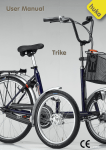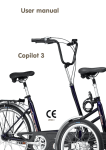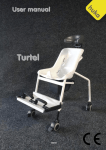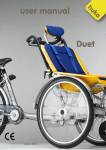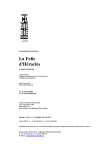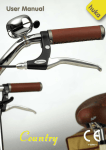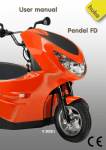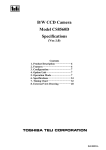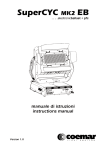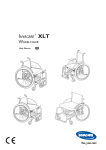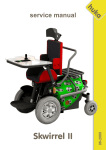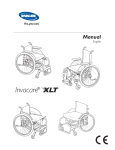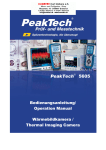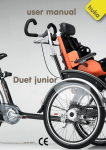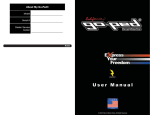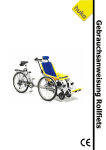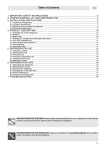Download User manual
Transcript
User manual Orthros 1 V 2014-1 Inhoudsopgave 1. MANUFACTURERS DETAILS ................................................................................................................ 4 2. INTRODUCTION ................................................................................................................................... 5 3. DECLARATION OF CONFORMITY ........................................................................................................ 6 4. WARRANTY ......................................................................................................................................... 7 5. INTENDED USE .................................................................................................................................... 8 6. SAFETY ................................................................................................................................................. 9 7. PRODUCT DESCRIPTION ................................................................................................................... 10 7.1 The frame .................................................................................................................................... 10 7.2 Mudguards .................................................................................................................................. 10 7.3 Drive mechanism ......................................................................................................................... 10 7.4 Wheels and tyres ......................................................................................................................... 11 7.5 Spokes.......................................................................................................................................... 11 7.6 Brakes (depending on model) ..................................................................................................... 11 7.7 Parking brake ............................................................................................................................... 12 7.8 Chain guard.................................................................................................................................. 12 7.9 Crankshaft, crank set and pedals ................................................................................................ 12 7.10 The chain ................................................................................................................................... 13 7.11 Gears (optional) ......................................................................................................................... 13 7.12 Seats .......................................................................................................................................... 13 7.13 Handlebars (depending on type and make) .............................................................................. 14 7.14 Lights (depending on country) .................................................................................................. 14 7.15 Luggage carrier .......................................................................................................................... 14 7.16 Electric motor (optional) ........................................................................................................... 15 7.17 Accessories ................................................................................................................................ 16 8. SET-UP ............................................................................................................................................... 17 8.1 The seat depth ............................................................................................................................. 17 8.2 Adjustment of handlebars ........................................................................................................... 18 8.3 The wheels................................................................................................................................... 22 8.4 Tyre pressure ............................................................................................................................... 22 9. USE .................................................................................................................................................... 23 9.1 Using for the First time ................................................................................................................ 23 9.2 Mounting ..................................................................................................................................... 23 9.3 Cycling.......................................................................................................................................... 23 9.4 Steering........................................................................................................................................ 23 9.5 Changing gears (optional)............................................................................................................ 24 9.6 Brakes (depending on model) ..................................................................................................... 24 9.7 Cycling with motor (optional)...................................................................................................... 25 2 9.8 Setting the electric motor assistance. ......................................................................................... 25 9.9 Cycling with motor using kick-start (optional) ............................................................................ 26 9.10 Moving and lifting the Orthros .................................................................................................. 28 10. MAINTENANCE................................................................................................................................ 29 10.1 User maintenance ..................................................................................................................... 29 10.2 Tightening various parts ............................................................................................................ 34 10.3 Parts replacement ..................................................................................................................... 35 10.4 Huka dealer maintenance ......................................................................................................... 35 11. DISPOSING OF THE PRODUCT......................................................................................................... 36 12. SELLING THE DUO BIKE ................................................................................................................... 37 13. TECHNICAL SPECIFICATIONS ........................................................................................................... 38 3 1. MANUFACTURERS DETAILS Huka B.V. Munsterstraat 13 7575 ED Oldenzaal The Netherlands tel. +31 (0541) 572 472 fax. +31 (0)541 520 415 mail: [email protected] web: www.huka.nl Huka BV Huka BV is a Dutch company that manufactures physical aids for disabled persons. Please contact your supplier if you have any questions about our products and their use. Changes Huka BV reserves the right to alter the product described in this manual. This frees us from any liability whats however. 4 2. INTRODUCTION Cycling is intended as an enjoyable activity. The fact that millions of people cycle their bikes every day with pleasure appears to bear out this fact. The bicycle is more than just a means of transport. It signifies freedom and a sende of adventure. Bicycles are kind to our environment; they give us that “green feeling”. However, not everyone is able to enjoy the pleasures of a common two-wheeler. Huka has added a series of three-wheelers to its range so that everyone can experience all the pleasurable aspects of cycling. Things like ergonomics, measurements, quality and look have played a very important part in their design. Your Huka Orthros duo-cycle is a quality product. Each and every component of your Huka three-wheeler has been rigorously tested. The frame and its added features are all made to the highest standards. This guarantees you both an excellent product and carefree enjoyment. When you receive delivery of your Huka three-wheeler, all of the parts will already have been fine-tuned according to your specifications. However modern it might be though, even an Huka three-wheeler is not maintenance-free. Sometimes there will be things that demand your attention. This manual contains instructions on the kind of maintenance you can carry out yourself and information about what your Huka dealer can do. Being able to carry out some of the maintenance yourself only adds to your level of enjoyment! Pay special attention to bold texts written in italics and to wherever you see this symbol. The texts in the green bars are supplementary information and demand extra attention. Make sure you read these carefully. 5 3. DECLARATION OF CONFORMITY Guidelines for medical aids 93/42/EEG for Class 1 medical aid Name of manufacturer: Huka B.V. Address of manufacturer: Munsterstraat 13, 7575 ED Oldenzaal, The Netherlands Product: Duo cycle Type/name: Orthros I, the undersigned, do hereby confirm that the above-mentioned medical aid meets with all the essential requirements as outlined in appendix 1 of the guidelines for medical aids 93/42/EEG. The product carries the CE seal of approval in accordance with above mentioned guidelines. Date: 01-04-2014 Name: B. Kamp, Managing Director Huka B.V. Signature: Huka B.V. Munsterstraat 13, 7575 ED, Oldenzaal, The Netherlands 6 4. WARRANTY Huka BV provides a two year warranty for the three-wheeler. This warranty will be administered by your dealer. This warranty does not apply to any damage to or faults in the three-wheeler arising from improper or indiscriminate use. This will be assessed by Huka BV or by a third representative appointed by Huka. NB: This warranty does not extend to parts that are subject to general wear and tear, such as chain, brakes and tyres. Should you notice a defect, please contact your supplier immediately. They will deal with your enquiry and if necessary, contact Huka BV. When submitting a claim under the warranty, it is of utmost importance that you provide us with the serial number. This number correlates to the date of delivery and time of production, as well as all parts Type/Typ : Max gewicht/Max weight KG : SN Huka BV : 2013-12 : 1312000 Postbus 194, 7570 AD Oldenzaal The Netherlands ,Tel: +31 (0) 541 572472 Goedgekeurd volgens/Approved to: EN 12182 Example of serial number sticker This serial number sticker can be found on the bottom of the rear axle. In case of damage or a defect please contact your supplier and provide them with the serial number. 7 5. INTENDED USE General guidelines The Huka Orthros duo cycle has been specially designed for people with a physical and/or mental disability. Cyclists who have developed a fear of falling find the Orthros duo cycle to be an excellent alternative when they want to be able to continue cycling carefree and comfortably. The Orthros duo cycles are also used by people who suffer from neuromuscular disorders (such as cerebral palsy, muscular dystrophy and spasms). This also applies to problems with coordination of movement, balance and limited natural body movement. Area of intended use The Orthros duo cycle has been designed for use on standard public roads and bicycle paths. These are usually paved, level and solid. The Orthros duo cycle conforms to all regulations in relation to use on public roads. The manufacturer is not liable when the Orthros duo cycle is used in areas other than those for which it is designed. 8 6. SAFETY Make sure that when you go cycling, you always do so safely. We recommend that you pay attention to the following before you go cycling: Make sure that your bike is in perfect condition before using it. Check the pressure and the conditions of the tyres. Check the brakes. Check your lights. Check that the Seats are securely fastened. Check that the handlebars are securely fastened. Check that there is no play in the wheels. Check that the battery (if applicable) is charged. If you are taking luggage with you, make sure that it is securely attached and cannot fall off while you are cycling. Always cycle on level and solid ground. Avoid potholes, high ramps and puddles. Do not bump against the kerb and do not cycle too fast off the kerb. Reduce your speed when cycling down hills or off exits Reduce your speed when cycling on wet and slippery surfaces. Use the parking brake when mounting/dismounting. Always lock your bike when not in use. The Orthros duo cycle is mainly made of steel which is regarded as non flammable. The other used materials, such as the plastic and rubber parts, are not flame retardant.. Use of the bike by children: Never allow small children to use the bike on public roads unattended by an adult. We advise to wear a reflective vest for children driving the bike. We advise that children should wear a safety helmet when cycling. Be safe when cycling! The Orthros duo cycle is not fire retardant! 9 7. PRODUCT DESCRIPTION 7.1 The frame The Orthros duo cycles are made of high-quality materials. The frame consists of a metal tube Construction with aluminum and steel parts. Most of the metals used are provided with an impact resistant coating. Together, the construction and finishing guarantee many years of enjoyment.. 7.2 Mudguards The mudguards are made of impact resistant plastic and are fully coated. They prevent water from splashing up onto one’s clothes. 7.3 Drive mechanism The duo cycle is equipped wit hits own specially designed drive mechanism for the rear wheels. This mechanism prevents the bike from veering off to one side (by means of a differential) making it easy to steer around turns (see fig. 2). Bike without differential Huka three-wheeler, with differential Fig. 2: Rear-wheel drive mechanism With the differential mechanism, each Wheel is driven independently of the other. This ensures that the bike continues in a straight line (image on the right) and that turns are easier to make. 10 7.4 Wheels and tyres The wheels have high-quality hubs, stainless steel spokes and aluminum rims. Topquality tyres are fitted to the rims. These ensure good grip and minimal rolling resistance and wear and tear. Tyre pressure and wear and tear of the tyres have a considerable effect on the behavior of your bike. Check your tyres regularly in order to ensure safety. 7.5 Spokes The spokes keep the wheels stable on the duo cycle. That’s why the right tension is so important. As spokes need some time to adjust and settle, the wheels should be checked after the First few weeks of use. Your Huka dealer will adjust the spokes to the right tension. Should a spoke become loose or break, your Huka dealer can fix this for you. Spoke tension has a considerable effect on the behavior of your bike. Check the spoke tension regularly in order to ensure safety. 7.6 Brakes (depending on model) The Orthros duo cycle comes equipped with a drum brake in the front wheel and two disk brakes on the rear wheels. The non-handicapped user can activate the brakes by hand levers. I fit is the case that an electromotor has been fitted, then a rim-brake will have been fitted in the front wheel. Brakes are extremely important when it comes to safe cycling. They can suffer from wear and tear over time. Have your brakes checked and adjusted regularly, and changed if necessary. This should only be done by an official Huka dealer. 11 7.7 Parking brake The Orthros duo cycle is equipped with a parking brake. This brake ensures that the bike cannot roll away when you are mounting or dismounting. Therefore, you should ensure that you have activated this brake before getting on or off the bike. You can activate the brake by pushing the handle fully forward. This applies the brake to the front wheel so that your bike is safely parked. Always use the parking brake when mounting and dismounting. This will prevent the bike from rolling away. You run the risk of falling if the bike moves away from you. 7.8 Chain guard The chain guards have been specially designed for these duo cycles and are made of impact resistant coated plastics. It prevents the chain from getting dirty and wet, and also ensures that the chains do not dirty your clothes. 7.9 Crankshaft, crank set and pedals The bottom brackets used by Huka are completely maintenance-free and nonadjustable. Should you encounter any problems then contact your Huka dealer. If you should notice any play between the crank and crank shaft, then you can remove the dust-cap and tighten the nut with a suitable wrench. The pedals are also usually maintenance-free. If you should notice any play, contact your Huka dealer. When fitting the pedals yourself, don’t forget to read the instructions for the L (left) and R (right) pedals. The left pedal is attached by turning anti-clockwise, the right clockwise. Use a spanner or a (small) pedal wrench. There are also other (adjusted) pedals available. See our brochure. 12 7.10 The chain When your chain has been tightened properly, your three wheeler will be easy to pedal and you won’t hear any noise from the chains. Your chains will already have been tightened properly by your Huka dealer before your bike is delivered. If you find that a chain is too loose, then get your Huka dealer to fix this. Both the chains and the drive mechanisms are protected by a plastic chain guard. Tightening the chains requires special skills and should be left to your dealer. 7.11 Gears (optional) Gears make cycling easier. They allow cyclists to cycle without having to exert too much effort, and in all kinds of weather. This cuts out the hard labour. The bike comes standard with a 8 gear, combined, if you wish, with a back-pedal brake or a coaster brake (reverse pedaling also possible). Adjusting the gears If you have chosen for a three-wheeler with gears, then there will be an extra hub between the pedals and the drive shaft. This is standard a 8 gear of Shimano, type Nexus, which has been adjusted for use on the Huka three-wheeler. Your Huka dealer will have checked and adjusted the gears before delivery of your bike. A manual explaining the workings of the relevant gear system will be supplied along with your three-wheeler. Contact your dealer is you have any problems. Adjusting the gear hub requires special skills. This should only be done by an authorized Huka dealer. 7.12 Seats The Seats provide comfort and stability when cycling. The Seats are adjustable in back and forward directions and can be rotated for easy access. It is very important that the seats are adjusted properly so that you can cycle efficiently, comfortable and safely. Make sure that the Seats always are locked properly. A not locked seat can be very dangerous. Check on regular basis whether the seat is still locked by the locking mechanism. 13 7.13 Handlebars (depending on type and make) The handlebars are made out of either steel or aluminum, depending on the bike and the type of handlebars. The handlebars can be adjusted for height. For some models also the angle and depth is adjustable. The main driver steers the bike, the steering of the passenger is a fixed type. Make sure that the handlebars are firmly attached. Loose fitted handlebars can be very dangerous. Check your handlebars regularly. 7.14 Lights (depending on country) The Orthros duo cycle comes with LED powered lights. The lights are very reliable and energy efficient. They use AA batteries, which are widely available and inexpensive. LEDs use a comparatively low amount of energy and are long lasting. The batteries can be changed easily. Make sure that you change the batteries before they run down, otherwise the lights will stop working. This can be very dangerous if that happens when you are cycling at night. 7.15 Luggage carrier The Orthros duo cycle standard comes with a luggage basket. This basket is mounted with four bolts with following specifications: Bolts: Button head screw with hexagon M6x10; minimum class 8.8 Make sure that the right parts are used fo mounting the luggage basket and that these are regurarly checked for tight. The loading of the basket must be equally spread left and right in order to influence the driving characteristics as little as possible. The maximum load of the luggage basket is 10 kgs. The total maximum load for the Orthros is 120 kg driver+120 kg passenger + 10 kg luggage=250 kg. 14 Changing the luggage basket will influence its safelty and is not allowed. The luggage basket is not suitable for attaching a child seat or a trailer. Whenever the luggage basket is loaded, this can influence the driving characteristics. It is advised to experience this in a safe area. When mounting specific luggage in or on the luggage basket, the instructions of that supplier must be followed. Pay special attention to loose straps that can ge tinto the spinning wheels. Light and retro reflectors are mounted aside the luggage carrier. Make sure that no luggage is blocking the free view on these lights and reflectors. 7.16 Electric motor (optional) The Orthros duo cycle can be fitted with an electric motor. This motor is attached to the front wheel. The battery pack and electronics are mounted on the main frame tube, with a users control and display on the steering of the main driver. Controls on the steering Display op the steering 15 Motor in the front Wheel Battery pack on the main tube Pas Vario system With this type of electrically assistance, there is a need for you to pedal yourself. To activate the motor. powered bicycle. The level of motor assistance is adjustable with the controls on the steering and can be viewed on the display. The bike is provided with a 36V 11Ah Li-ion battery that is mounted on the main tube of the frame. 7.17 Accessories There are a number of accessories available for the Orthros. For example, armrests, a footrest, etc. (see our special brochures). 16 8. SET-UP 8.1 The seat depth Correct adjustment of the seat will make it almost comfortable as a good chair and enable you to cycle long distances with ease. There is a useful rule-of –thumb for adjusting the seat properly. Remove your shoes and sit on the bike with the pedal crank extended straight from you. With your heel on the pedal, you should just be able to stretch your leg fully. This is the ideal “working distance” for when cycling with the ball of your foot (with shoe) on the pedal. You can make slight adjustments to the saddle distance in order to find the one most comfortable distance for you. 1. Pull the lever under the seat to unlock the seat. 2. Slide the seat to the requested position. 3. Release the lever and move slightly back and forward in order to allow the locking mechanism to fall into the slot. This can both be heard and felt. 8.1.1 Turning the seat You can turn the seat to make it easier to get in en out. 1. Put the seat in the front position. See 8.1 seat depth 2. Pull the hendle up to rotate the seat. 3. Turn the seat in the right position. 4. Turn the seat back and move the seat a bit till you hear that the seat Make sure that you lock the seat properly again. A loosefitting seat may slip when you are cycling. This can be dangerous. 17 8.2 Adjustment of handlebars Height of handlebars 1. Use a size 6 Allen key to loosen the handlebars bolt, so that you can move the handlebars. 2. Pull or push the handlebars to the desired height. 3. Tighten the handlebars bolt again. Make sure that enough length of the handlebar stem is still in the main frame. The safety marking on the stem must therefore remain inside the main frame. Angle of handlebars 1. Use a size 6 Allen key to loosen the handlebars bolt, so that you can move the handlebar. 2. Pull or push the handlebars to the desired angle. 3. Tighten the handlebars bolt again. Sometimes the handlebars may be stuck very tightly and can’t be moved even when you loosen the bolt. If that is the case, use a plastic or rubber hammer to loosen the bolt. When you strike it, it will slip down slightly and the handlebar will become loose. 18 Make sure that you tighten the handlebar properly again. Loose-fitting handlebars may slip while you are cycling. This can be dangerous. Height of Multi-adjustable handlebars pipe 1. Use a size 6 Allen key to loosen the handlebars bolt, so that you can move the handlebar. 2. Pull or push the handlebars to the desired height. 3. Tighten the handlebars bolt again. 19 Angle of handlebars pipe 1. Use a size 6 Allen key to loosen the handlebars angle bolt, so that you can move the handle bars. 2. Push or pull the handlebars to the desire angle. 3. Tighten the handlebars bolt again. Make sure that you tighten the handlebars properly again. Loose-fitting handlebars may slip while you are cycling. This can be dangerous.. 20 Angle of handlebars 1. Use a size 6 Allen key to loosen the handlebars angle bolts, so that you can move the handle bars. 2. Push or pull the handlebars to the desire angle. 3. Tighten the handlebars bolts again. 1) Unlock the lever 2) Pull upwards 3) Adjust handlebars to the desired position 4) Lock the lever again. 21 8.3 The wheels The Wheel is the most important part of the bike with regard to troublefree cycling and comfort. A number of features are important, including well pumped tyres, tightly fixed spokes and supple, play-free movement. Before using your bike, check that the wheels are turning freely and not squeaking. Squeaking noises are often an indication of loose spokes or faulty bearings. If you should notice this then contact your dealer. 8.4 Tyre pressure For most tyres, the pressure is correct when you can squeeze the tyre a little using your thumb and finger. If your tyres are too soft then they will wear out quicker, while cycling on hard tyres is much more comfortable and ensures that your three-wheeler reacts better to braking and steering. The inner tubes on the three-wheeler are fitted with a “normal” valve. You can pump up your tyres yourself. 22 9. USE 9.1 Using for the First time When using your Orthros duo cycle for the First time, find yourself a large, unoccupied area where you can try it out. Recommendations for safe cycling: Use a safety helmet. Check before using the condition and functioning of brakes, tyres, rims and steering. Braking distance can be longer under wet weather conditions. Inform yourself about relevant regulations for the use of the bike on public roads. 9.2 Mounting Activate the parking brake before mounting. This makes mounting the bike easier and safer. Some models have a step on the frame. The seat can be turned outward for easy accessibility. Lever hereto the handle under the seat. Make sure that you hear and feel the locking mechanism falling into the slot. Eventually move the seat back and forward a little. 9.3 Cycling Release the parking brake and start pedaling slowly. The bike will start moving. If you have a bike with gears, make sure it is in First gear. This makes it easier to start pedaling. 9.4 Steering At first, steering a three-wheeler might seem a little different to steering an ordinary bike. The three-wheeler tends not to lean naturally into a turn. Use your arms, and not your body, to steer. For sharp turns, lean your body slightly into the turn. This will keep both you and your bike stable. Reduce speed when turning. Especially on Sharp turns. Turning too fast will reduce your stability. This can lead to physical and/or material damage. Avoid sudden and exaggerated turning movements. These will destabilize you and your bike. This can lead to physical and/or material damage. 23 Certain materials can get excesive hot by exposure to direct sunlight A duo cycle has moving parts. Be aware of pinching . Be alert on interferance between electronic equipment and your bike when your electric motor system is on.. 9.5 Changing gears (optional). If your bike is fitted with gears, you can use them to adjust speed. To change gear, first stop pedaling. Then turn the gearshift to select the desired gear. The selected gear will be displayed on the gearshift. Once you have chosen the desired gear, you can start pedaling again. Do not pedal while changing gears. This can damage the gear mechanism. Damage to the gear hub resulting from misuse is not covered under the warranty. 9.6 Brakes (depending on model) The left brake lever is used for activating the rear brakes. The right brake lever is used for activating the front brake.. 24 There are several options for braking. The brakes are activated by the main driver. The passenger has no brakes. Back-pedal brake The back-pedal brake is activated by pedaling backwards instead of forwards. This works on both rear wheels via the intermediate shaft. This brake is optional available. Handbrakes You can brake a duo cycle with handbrakes by squeezing both levers on the handlebars. This activates the brakes on both the front and rear wheels. The right hand lever activates the brake on the front Wheel, the one on the left those on the rear wheels. It is best to use the left-hand brake when turning. Practice using the brakes in a large, enclosed area before taking your bike out on the road. In this way you can get used into using them. Be careful when using the front brakes while turning as this can destabilize the bike. This can lead to physical and/or material damage. Some models are fitted with both a back-pedal brake and handbrakes. In that case you can use both if you wish. The braking characteristics of the three-wheeler change on surfaces that are slippery, wet or uneven. Adjust your use of the brakes accordingly. 9.7 Cycling with motor (optional) If your three-wheeler is fitted with a motor, then follow these instructions. A pedal sensor registers when you start to pedal. This then activates the electric motor, which makes pedaling easier. The motor will stop as soon as you stop pedaling. 9.8 Setting the electric motor assistance. By pushing the arrow-buttons on the control unit, the level of electric motor assistance can be set. The display will show the setting accordingly. 25 Arrow-buttons 9.9 Cycling with motor using kick-start (optional) The kick-start option is meant for easy start from standstill. By holding the “arrow-up button” the motor is activated and brings the cycle to a speed of 6 km/h. Releasing the button will stop the motor (when there is still no pedal movement). Bedieningstoetsen The motor assistance is activated or de-activated by pressing the “mode button” three seconds. 26 Battery indicator You can find the battery indicator on the display. It indicates the current level of the battery. When all the blocks are black, the battery is fully charged. The blocks will show empty when there is less battery power left. Battery indicator It is also possible to use the indicator on the battery. Push the button and the indicator gives the amount of energy. By 5 led’s the battery is full, By 1 led the battery is almost empty. Battery pack Battery indicator Check to see if the battery is full before setting out a long trip so that you won’t be left stranded halfway. The battery charger fits into a pocket on the battery pack. Take it with you so that you can always charge up if required. 27 9.10 Moving and lifting the Orthros To move or lift the bike you can grab at the back of the black connecting rods and the front of the head tubes. We recommend to lift the bike with at least three people and also to hold the front wheel and steering to prevent it from turning and causing injuries. 28 10. MAINTENANCE 10.1 User maintenance In order to be able to enjoy your Orthros for a long period of time, it is important that maintenance be carried out regularly. First maintenance check After the first 200 kilometres, o rafter using the bike for two months, you should have it checked by your Huka dealer. Every bike needs some time to “kick in”. During this first check your dealer will check the nuts and bolts, the chain, spokes etc.. The first check should always be carried out by an authorised Huka dealer. Checks carried out by unauthorised personnel can affect the warranty. Cleaning Clean the bike regularly. You can do this using warm water and a non-abrasive cleansing agent. Special cleansing agents are available at most bicycle stores. Do not use a power hose or steam cleaner to clean your bike as they will remove the grease from the bearings etc.. The rims can be cleaned using warm water and-or a soft haired brush. Never use a wire brush to clean the rims as this will damage them. Tyre pressure Check the tyre pressure once a week. The correct tyre pressure ensures a smooth and reliable ride. The tyres have normal valves, which means that you can use any bicycle pump to inflate them. The correct tyre pressure is 5 bar. After pumping your tyres, always check the valves to make sure they are not leaking. To do this, rub some saliva on the valve. If you see bubbles then the valve is leaking and needs to be replaced. Make sure that the tyre pressure is and remains correct. Not enough tyre pressure will result in more resistance and steering difficulties when cycling. 29 Tyre tread Controleer eens per maand het profiel van de banden. Deze moet voldoende zijn om goede wegligging te kunnen garanderen. Check the tyre tread of your tyres once a week. They should be in such a condition as to guarantee proper grip. If the tread is less than 1 mm deep then the tyres need replacing. Replacing tyres requires a certain amount of skill. Let your Huka dealer do this for you. Replace the tyres with the same model and/or brand. This will ensure good grip. Spokes and rims The tension of the spokes needs to be checked every month. A squeaking noise is usually a sign that a spoke is loose. A loose spoke can cause the rim to buckle, which affects the behaviour of the bike. You can check the spokes by stroking them like you would the strings of a guitar. A spoke that sounds off is probably loose. Inform your Huka dealer of this. . Fixing spokes is specialised work. Leave it to your authorised Huka dealer. The rims are made of stainless steel and require no maintenance except regularly cleansing. Because there is no rim brake used, the rims do not suffer from mechanical wear. Damaged or deformed rims can be unsafe. These rims need to be replaced by your Huka dealer. Chains The chains should be cleaned and oiled once a month. There are special cleansing agents for doing this that you can find in any bicycle store. They also sell special grease and sprays. The tension of the chain is also important and should be checked regularly. As the chain guard needs to be opened before the chain can be cleaned and tightened, you should let your Huka dealer do this for you. Adjusting the chain is specialised work. Leave it to your authorised Huka dealer. 30 Gears The gears are a delicate and complex mechanical system. Contact your Huka dealer if you have any trouble with the gears. He will have the required know-how and equipment to adjust them for you. Brakes The brakes are extremely important and need to be tested regularly. Check them at least once a week. A loosely fitted brake will not provide enough braking power. The brakes can be tightened using the nut on the brake lever. Adjusting nut Lock nut In order to tighten the brakes, turn the adjusting nut outward. Lock it into position by twisting the lock nut. The brakes are of the disc brake, drum brake or back pedaling brake type. These brakes do not need maintenance. If, after adjusting, the brakes still do not function properly, have them checked, adjusted and in some cases replaced by your Huka dealer. Lights The Orthros duo cycle comes equipped with battery-operated LED lights. The batteries should last a very long time as LED lights use very little energy. They will eventually run out, however, and will then need to be replaced. The batteries used are of the AA type and can be bought in almost any convenience or hardware store. Batteries fall under the category for chemical waste and should be disposed in the proper manner. 31 Changing the headlamp batteries There is a nut underneath the headlamp. This nu can be loosened with a coin or screwdriver so that the face of the headlamp can be lifted up. Loosen the nut raise and lift off the face < Change batteries clip face back on Replace the old batteries with new ones. Pay attention to the + and – signs on the batteries. Attach the face at the top of the housing once more and press the face into the housing until you hear a click. Place the nut in the housing and tighten it. Incorrectly installed batteries can result in damage to the headlamp. Make sure that the + and – signs are properly aligned. 32 Changing rear light batteries The face of the rear light is attached with a clip on the bottom. Press this clip downward carefully and pull off the face. Open the screw in the front turn the lamp forwards Replace the batteries put the lamp back on the hooks and fasten the screw Incorrectly installed batteries can result in damage to the headlamp. Make sure that the + and – signs are properly aligned. 33 Charging the batteries (for bikes with motors) Before going out on your bike, check to make sure your battery is sufficiently charged for your trip. If not, make sure you charge it. To charge the battery, connect it to the battery pack. Checking the battery Battery connected to the charger Plug the battery into a mains socket. The battery will now begin charging. This usually takes 3 to 6 hours, depending on battery capacity. Low temperatures have an adverse effect on the charging of batteries. If the outside temperature is lower than 10 degrees, then you should charge the battery indoors. 10.2 Tightening various parts It is essential that crucial parts of the bike are tightened properly. These parts should be tightened with the right torque. In following table these torques are specified. 34 Not tightening with the right torque can cause dangerous situations.. Part Bolt for handlebar Bolt for Stearing post Bolt for back wheel Bolt for front Wheel drumbrake Bolt for front Wheel with motor Torque (Nm) 40 20 8,4; and use Locktite 27 40 10.3 Parts replacement Turn to your Huka dealer for replacement of parts. For replacement of inner- and outer tubes, use sizes as given below Inner- and outer tube front wheel: Inner- and outer tube rear wheels: 47-507 47-406 10.4 Huka dealer maintenance You should have your Orthros duo bike checked by an authorised Huka dealer at least once a year. They will check the working, safety, and wear and tear of your duo bike. Contact your Huka dealer immediately if you notice a defect or malfunction. . Contact your Huka dealer immediately in the case of a defect. Use the bike as little as possible until the defect has been repaired. If you or someone else tries to fix the duo bike, you run the risk of not doing the job properly. This nullifies your warranty. Always replace parts with original Huka parts. Your Huka dealer can order and replace these for you. 35 11. DISPOSING OF THE PRODUCT If you no longer wish to use the duo bike or wish to dispose of it, contact your Huka dealer. To scrap the bike you can contact your local waste disposal service. They will dispose of the three-wheeler in accordance with local rules and regulations. Batteries and battery packs fall under the category for chemical waste and should be disposed of in the proper manner. 36 12. SELLING THE DUO BIKE If you wish to sell your Orthros duo bike to someone else, it is important that you hand over all technical documents as well so that the new owner can use the bike safely. Have the bike checked by an authorized dealer before you sell it so that you can be sure that the Orthros duo bike is in good condition. If you would like to buy an used duo bike yourself, you should First have it checked by an authorised Huka dealer. They will be able to judge the condition of the bike and spot any hidden defects. 37 13. TECHNICAL DETAILS 2. GEGEVENS FABRIKANT Material frame Coating Wheels Lighting Bell Mud guards Chain guards Handlebar and seat post Handlebar grips) Seats Brakes Drive Options Warranty Warranty optional batteries Technical lifetime Steel Epoxy coating (outdoor quality) Aluminium met elektrolytisch verzinkte naaf en RVS spaken LED head and rear lights Sportive and modern bell Impacty proof plastics Impact proof plastic housing Aluminum Plastic (basic handlebar), foam grips on sporty handlebar Plastic seat shells Either pedal brake and/or drumbrakes and parking brake Mid-axle gear and differential in rear axle Please refer to order form 2 Years, parts that wear are not included 1 Year 7 years Length in mm (H) Width in mm Weight in kgs Crank length (A) Inner leg length Height saddle-floor in mm (C) Height Back support (D) Height of handlebar (E) Height range handlebar (F) Width handlebar in mm Maximum load/seat in kgs Maximum Total load in kgs Wheel size front (ETRTO) Wheel size front (Inch) Wheel size rear (ETRTO) Wheelsize rear (Inch) Huka BV postbus 194 7570 AD Oldenzaal Nederland 2050 mm 1050 mm 68 kg 150 mm 720–920mm 635 mm 980 mm 1260 mm 250 mm 500 mm 120 kg 250 kg 47-507 24 x 1.75 47 - 406 20 x 1.75 T. +31 (0) 541 - 572 472 F. +31 (0) 541 - 520 415 [email protected] www.huka.nl 38 39 Your local supplier: Huka BV Munsterstraat 13 7575 ED Oldenzaal The Netherlands tel: +31 (0)541 572 472 fax. +31 (0)541 520 415 mail: [email protected] www.huka.nl 40









































